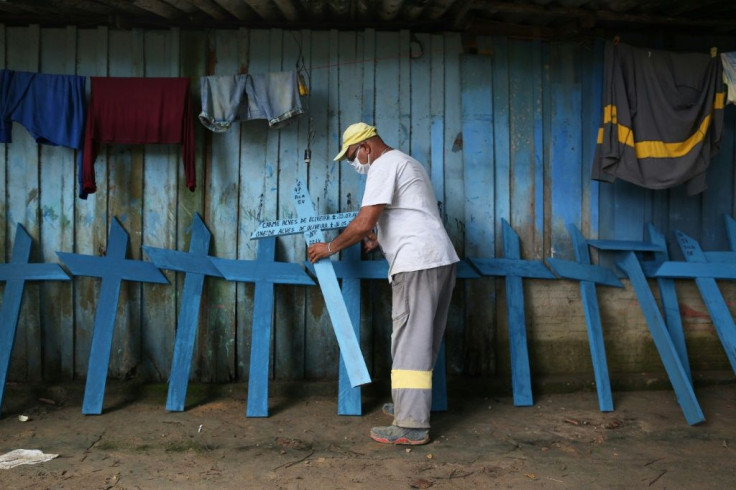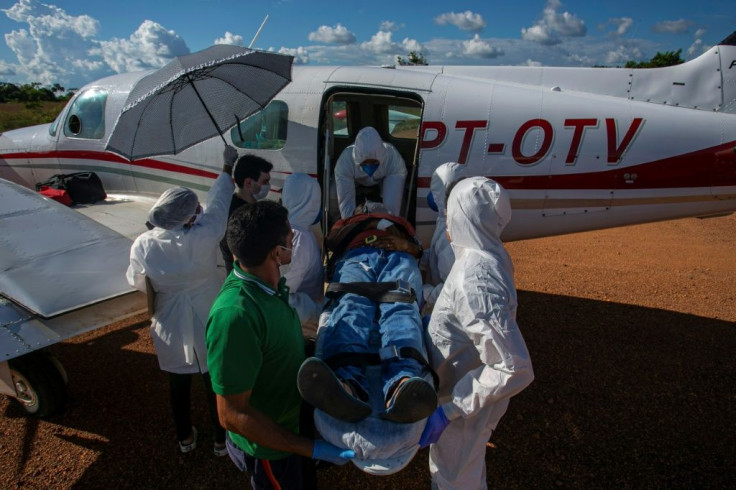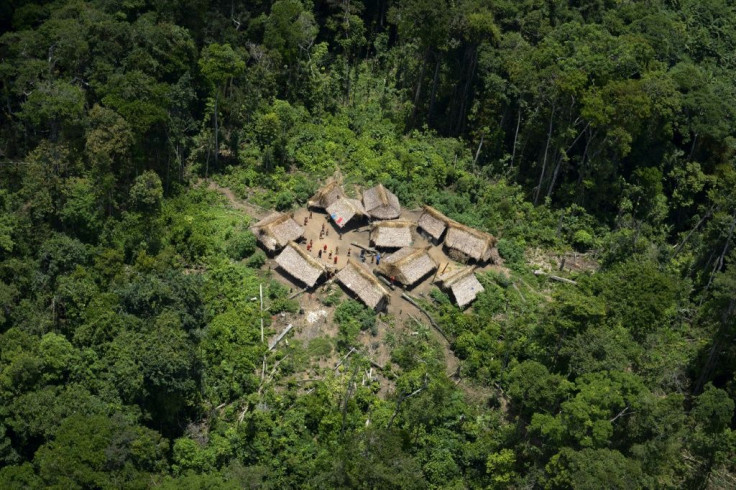Coronavirus Pandemic Leaves Amazon More Vulnerable Than Ever
The indigenous peoples of the Amazon have already seen their homelands ravaged by illegal deforestation, industrial farming, mining, oil exploration and unlawful occupation of their ancestral territories.
Now, the coronavirus pandemic has magnified their plight, just as the forest fires are raging once more.

The Amazon, the world's largest tropical rainforest, is a vital resource in the race to curb climate change -- it spans over 7.4 million square kilometers (2.85 million square miles).
It covers 40 percent of the surface area of South America, stretching across nine countries and territories: Brazil, Bolivia, Colombia, Ecuador, French Guiana, Guyana, Peru, Suriname and Venezuela.
Around three million indigenous people -- members of 400 tribes -- live there, according to the Amazon Cooperation Treaty Organization (ACTO). Around 60 of those tribes live in total isolation.

The following is a look back over at how the novel coronavirus spread through the Amazon jungle, and how those communities are handling the crisis.

In mid-March, panic struck Carauari, in western Brazil.
Carauari is home to one of the most isolated communities in the world, and is only accessible by a week-long boat ride from Manaus, the nearest major city.

At first, the virus was seen as a threat that was well removed from the multi-colored houses on stilts that overlook the Jurua river, a tributary of the Amazon.
But the announcement of the first case in Manaus, the regional capital of Amazonas state, quickly sowed panic in the community.
No one in Carauari had forgotten how diseases brought by European colonizers ripped through the native populations in the Americas, nearly eliminating them altogether due to their lack of immunity.

"We're praying to God not to bring this epidemic here. We're doing everything we can -- washing our hands often, like they tell us on TV," said Jose Barbosa das Gracas, 52.
The first confirmed case amongst Brazil's indigenous population was confirmed in early April: a 20-year-old health care worker from the Kokama tribe, who lived near the Colombian border.
She had worked with a doctor who also tested positive.

Sensing the mounting threat, indigenous leaders and celebrities sounded the alarm, warning that Amazonian indigenous communities could face annihilation without help.

"There are no doctors in our communities. There is no protective gear to aid prevention," Jose Gregorio Diaz Mirabal, the elected leader of the collective of Amazon indigenous organizations, said in late April.
For Yohana Pantevis, a 34-year-old inhabitant of Leticia, in Colombia's Amazonas state, "falling ill here is always scary, but now we're more afraid than ever."

Brazilian-born photojournalist Sebastiao Salgado, known for his work in the Amazon, warned of the "huge risk of a real catastrophe."
"If the virus gets into the forest, we don't have a way to get help to them. The distances are so huge. The indigenous people will be abandoned," said the 76-year-old.
"I call that genocide -- the elimination of an ethnic group and its culture," he said, accusing the government of Brazil's far-right President Jair Bolsonaro of anti-indigenous policies.

In early June, iconic indigenous leader Raoni Metuktire accused Bolsonaro of wanting "to take advantage of this disease."
"He's saying, 'Indians have to die, we have to finish them off'," he told AFP in an interview.

In mid-June, the little indigenous village of Cruzeirinho in Brazil with its wooden huts was left practically deserted as most inhabitants -- fearing coronavirus infection -- fled into the jungle.
They "preferred to take everything they had with them into the forest and avoid contact with others," said resident Bene Mayuruna, who was amongst the few who stayed.

The Brazilian army deployed a team of health workers to Cruzeirinho to provide care for the remaining members of the local tribe.

A week's journey by boat from Cruzeirinho, the inhabitants of the Umariacu indigenous reserve adopted a different strategy: they blocked all outsiders from their villages.
"Attention: indigenous land. Closed for 15 days," said a hand-painted sign next to a roadblock at the entrance to the reserve.

The area covers 5,000 hectares (12,000 acres) in northern Brazil near the Peruvian and Colombian borders, and is home to about 7,000 people.
To avoid any dependence on the often maxed-out Brazilian public health system, indigenous people often turn to their ancestral traditions.
In mid-May, members of the Satere Mawe ethnic group, wearing colorful feather and leaf headdresses, scoured the river in search of medicinal plants.
"We've been treating our symptoms with our own traditional remedies, the way our ancestors taught us," said Andre Satere Mawe, a tribal leader who lives in a rural area on the outskirts of Manaus.
The Satere Mawe remedies include teas made from the bark of the carapanauba tree, which has anti-inflammatory properties, or the saracuramira tree, an anti-malarial.
In Manaus, Maria Nunes Sinimbu saw five members of her family die of COVID-19 in less than a month, including three of her 12 children.
"My daughter didn't believe this illness was so serious. She kept working and traveling normally, without taking any precautions," said the 76-year-old retired school teacher.
In late July, the Pan-Amazonian Church Network said more than 27,500 indigenous people belonging to 190 tribes had been infected on the continent with over 1,100 deaths.
Amongst the victims have been important tribal leaders such as Paulinho Paiakan and Aritana Yawalapiti in Brazil, and Peru's Santiago Manuin.
For many indigenous people living deep in the rainforest, the health crisis has left them with a cruel choice: stay in their villages with limited medical resources or head into bigger towns where they might not be able to practice ancestral funeral rites.
Brazilian Lucita Sanoma lost her two-month-old baby on May 25. The boy was buried, without her knowledge, 300 kilometers (185 miles) from her home village after dying in a hospital in Boa Vista.
The burial followed government health guidelines but ran counter to the traditions of her Yanomami tribe, which dictate that the deceased must be left in the open air in the forest before their bones are collected and cremated.
The ashes are kept in an urn for a long time before eventually being buried in a new ceremony.
In Colombia, Ticuna chief Remberto Cahuamari spoke in early June of his concern that the loss of the older generation to COVID-19 would spell the end of the passing down of ancestral wisdom.
"We'd be left with our young who in the future won't know anything about our cultures and our customs. That's what scares us," he told AFP.
Added to that is the threat of isolation as riverside villages become cut off as authorities suspend boat traffic in a bid to curb the spread of the virus.
For the Yanomami people, illegal gold miners are the main problem on their territory, a vast swathe of territory on Brazil's border with Venezuela that is home to about 27,000.
"Without that, we would be fine," said indigenous leader Mauricio Yekuana, whose white mask contrasts with his black face paint.
According to NGOs, around 20,000 gold miners make regular incursions into indigenous land, encouraged by Bolsonaro, who wants to "integrate" those areas with "modernity."
But Greenpeace Brazil warns that gold miners are "potential transmitters" of COVID-19.
A study conducted by Minas Gerais University showed that as many as 40 percent of Yanomami living close to mining areas risked becoming infected with the virus if nothing is done.
While the world's attention is laser-focused on the coronavirus, forest fires continue to ravage the Amazon, after an already challenging 2019.
Land-grabbers in Brazil want to accelerate deforestation to make way for soybean plantations or pasture land for cattle -- two key exports. The resumption of fires is no accident.
"What I saw in the places I went to was that the trees had already been cut down, they just hadn't yet been burnt," Erika Berenguer, a researcher at Oxford and Lancaster universities, said in June.
She feared that "breathing problems caused by the fires" could make things worse for those who contract the coronavirus.
Authorities have a limited ability to prevent deforestation -- and sometimes are found to be complicit in the operations.
The latest figures make for some grim reading: Amazonian deforestation over the first half of the year was 25 percent higher than the same period in 2019, which was already a record, Brazil's national space agency INPE said.
Experts fear August will be particularly devastating.
© Copyright AFP 2024. All rights reserved.





















